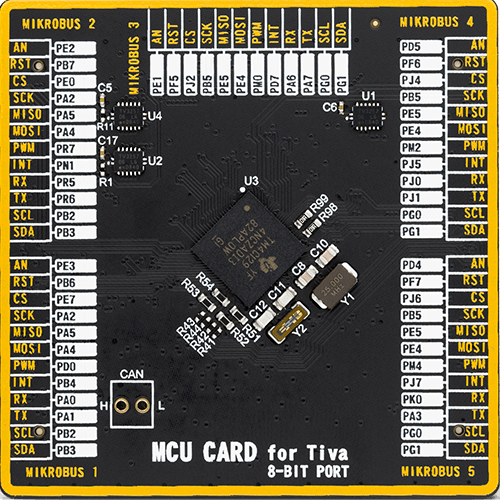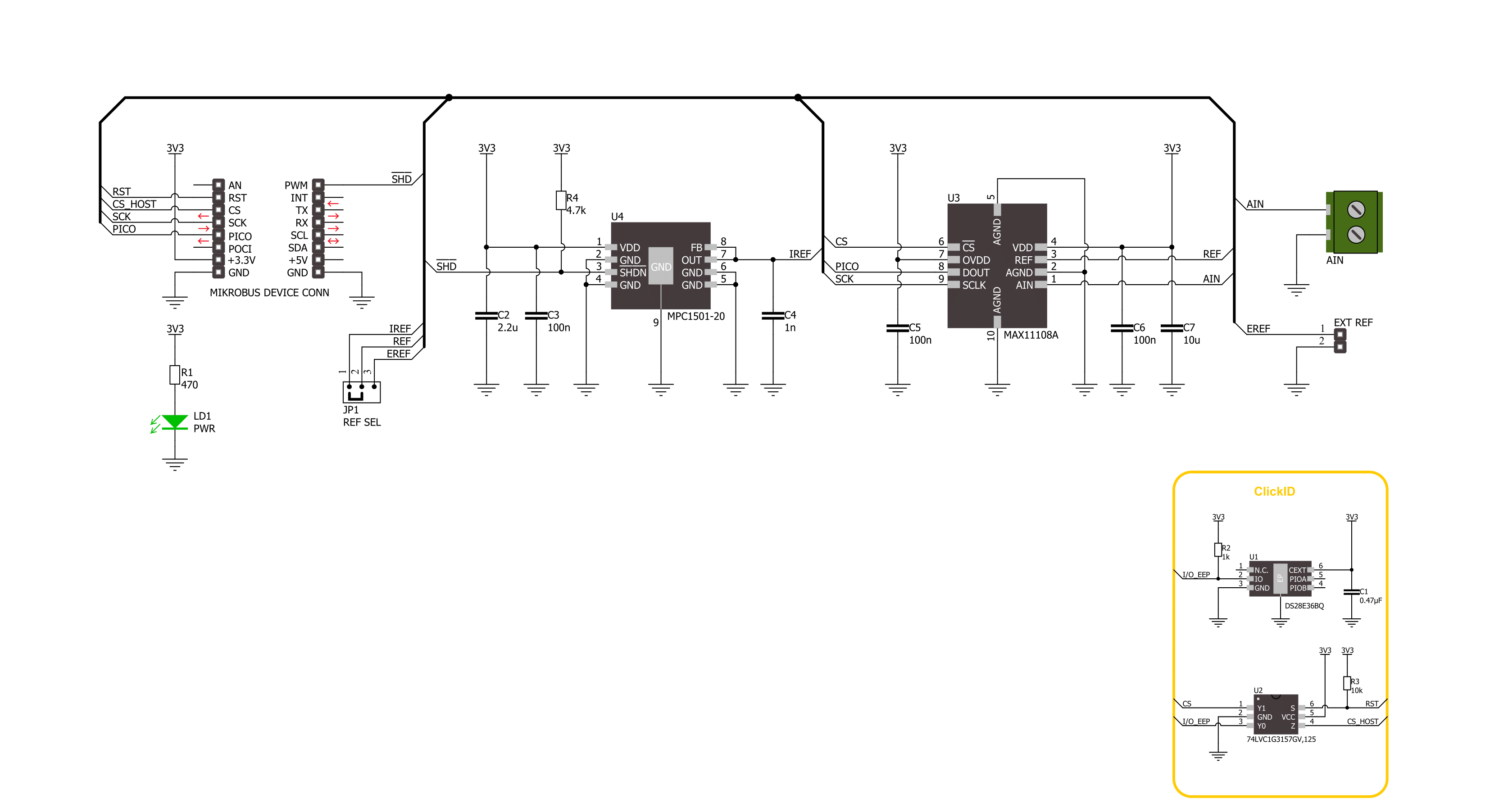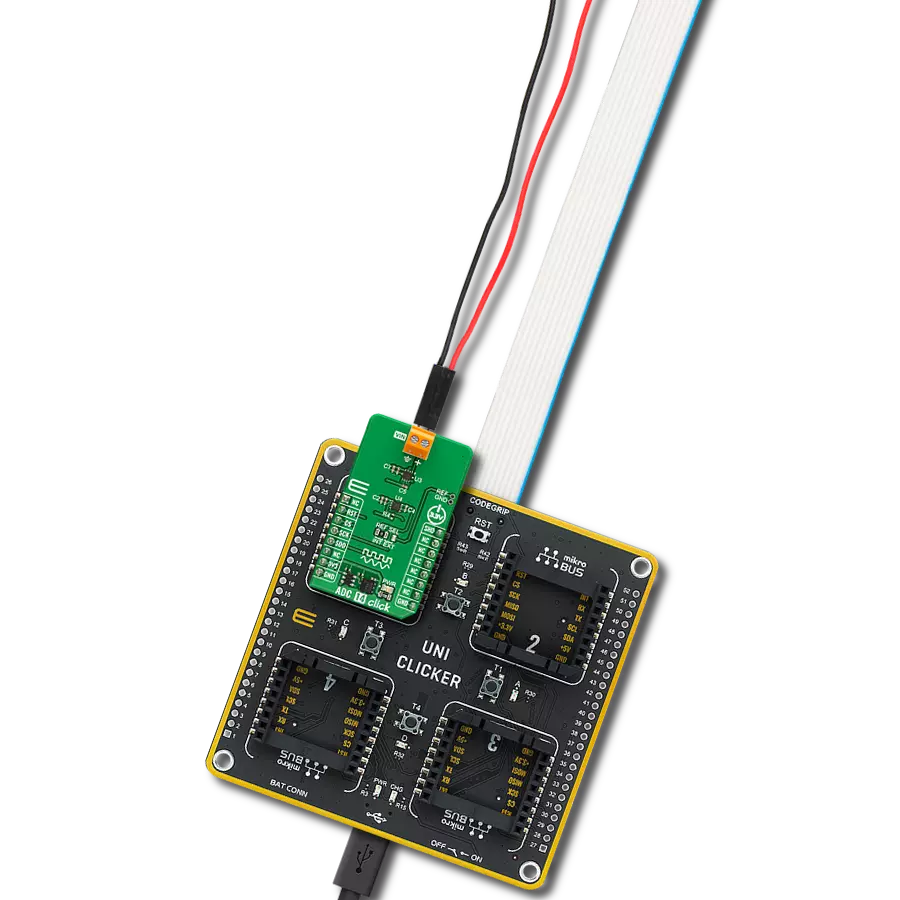Our ADC solution stands as a beacon of precision, seamlessly translating analog signals into a digital format with unmatched accuracy, ensuring your data speaks with clarity and depth.
A
A
Hardware Overview
How does it work?
ADC 14 Click is based on the MAX11108A, a low-power serial ADC from Analog Devices. This 12-bit ADC includes a full power-down mode and a fast wake-up for optimal power management, consuming only 6.6mW while sampling up to 3Msps. The low power consumption extends battery life, as it can go as low as 2.5μA/ksps and even lower in power-down mode. The MAX11108A samples from the analog input in the normal mode of operation while the device is powered up at all times, thereby achieving its maximum throughput rates. In addition, the ADC can operate with 14 cycles per conversion. The ADC 14 Click
accepts a full-scale input from 0V to the power supply or the reference voltage. The digital output corresponds to the analog input over the 2-pin screw terminal. ADC 14 Click can use internal or external as a reference voltage, which you can select over the REF SEL jumper (internal reference selected by default). The MCP1501, a high-precision buffered voltage reference from Microchip, provides a 2.048V internal reference voltage. In addition, you can use an external reference voltage, which you can connect over the REF header. ADC 14 Click uses a 3-Wire (read-only) SPI serial interface to communicate with the
host MCU, supporting up to 48MHz serial clock frequency. The SHD shutdown pin of the mikroBUS™ socket is used to shut down the MCP1501 with a Low logic state if the MCP1501 is not in use. This Click board™ can be operated only with a 3.3V logic voltage level. The board must perform appropriate logic voltage level conversion before using MCUs with different logic levels. Also, this Click board™ comes equipped with a library containing easy-to-use functions and an example code that can be used as a reference for further development.
Features overview
Development board
UNI Clicker is a compact development board designed as a complete solution that brings the flexibility of add-on Click boards™ to your favorite microcontroller, making it a perfect starter kit for implementing your ideas. It supports a wide range of microcontrollers, such as different ARM, PIC32, dsPIC, PIC, and AVR from various vendors like Microchip, ST, NXP, and TI (regardless of their number of pins), four mikroBUS™ sockets for Click board™ connectivity, a USB connector, LED indicators, buttons, a debugger/programmer connector, and two 26-pin headers for interfacing with external electronics. Thanks to innovative manufacturing technology, it allows you to build
gadgets with unique functionalities and features quickly. Each part of the UNI Clicker development kit contains the components necessary for the most efficient operation of the same board. In addition to the possibility of choosing the UNI Clicker programming method, using a third-party programmer or CODEGRIP/mikroProg connected to onboard JTAG/SWD header, the UNI Clicker board also includes a clean and regulated power supply module for the development kit. It provides two ways of board-powering; through the USB Type-C (USB-C) connector, where onboard voltage regulators provide the appropriate voltage levels to each component on the board, or using a Li-Po/Li
Ion battery via an onboard battery connector. All communication methods that mikroBUS™ itself supports are on this board (plus USB HOST/DEVICE), including the well-established mikroBUS™ socket, a standardized socket for the MCU card (SiBRAIN standard), and several user-configurable buttons and LED indicators. UNI Clicker is an integral part of the Mikroe ecosystem, allowing you to create a new application in minutes. Natively supported by Mikroe software tools, it covers many aspects of prototyping thanks to a considerable number of different Click boards™ (over a thousand boards), the number of which is growing every day.
Microcontroller Overview
MCU Card / MCU

Type
8th Generation
Architecture
ARM Cortex-M4
MCU Memory (KB)
1024
Silicon Vendor
Texas Instruments
Pin count
212
RAM (Bytes)
262144
Used MCU Pins
mikroBUS™ mapper
Take a closer look
Click board™ Schematic

Step by step
Project assembly
Track your results in real time
Application Output
1. Application Output - In Debug mode, the 'Application Output' window enables real-time data monitoring, offering direct insight into execution results. Ensure proper data display by configuring the environment correctly using the provided tutorial.

2. UART Terminal - Use the UART Terminal to monitor data transmission via a USB to UART converter, allowing direct communication between the Click board™ and your development system. Configure the baud rate and other serial settings according to your project's requirements to ensure proper functionality. For step-by-step setup instructions, refer to the provided tutorial.

3. Plot Output - The Plot feature offers a powerful way to visualize real-time sensor data, enabling trend analysis, debugging, and comparison of multiple data points. To set it up correctly, follow the provided tutorial, which includes a step-by-step example of using the Plot feature to display Click board™ readings. To use the Plot feature in your code, use the function: plot(*insert_graph_name*, variable_name);. This is a general format, and it is up to the user to replace 'insert_graph_name' with the actual graph name and 'variable_name' with the parameter to be displayed.

Software Support
Library Description
This library contains API for ADC 14 Click driver.
Key functions:
adc14_get_voltage- ADC 14 get voltage function.adc14_read_conversion_data- ADC 14 read conversion data function.adc14_set_vref- ADC 14 set voltage reference function.
Open Source
Code example
The complete application code and a ready-to-use project are available through the NECTO Studio Package Manager for direct installation in the NECTO Studio. The application code can also be found on the MIKROE GitHub account.
/*!
* @file main.c
* @brief ADC 14 Click example
*
* # Description
* This example demonstrates the use of the ADC 14 Click board™
* by reading results of AD conversion by using SPI serial interface.
*
* The demo application is composed of two sections :
*
* ## Application Init
* Initialization of SPI module and log UART and enabled internal voltage reference.
*
* ## Application Task
* The demo application reads the voltage levels from analog input and displays the results.
* Results are being sent to the UART Terminal, where you can track their changes.
*
* @author Nenad Filipovic
*
*/
#include "board.h"
#include "log.h"
#include "adc14.h"
static adc14_t adc14;
static log_t logger;
void application_init ( void )
{
log_cfg_t log_cfg; /**< Logger config object. */
adc14_cfg_t adc14_cfg; /**< Click config object. */
/**
* Logger initialization.
* Default baud rate: 115200
* Default log level: LOG_LEVEL_DEBUG
* @note If USB_UART_RX and USB_UART_TX
* are defined as HAL_PIN_NC, you will
* need to define them manually for log to work.
* See @b LOG_MAP_USB_UART macro definition for detailed explanation.
*/
LOG_MAP_USB_UART( log_cfg );
log_init( &logger, &log_cfg );
log_info( &logger, " Application Init " );
// Click initialization.
adc14_cfg_setup( &adc14_cfg );
ADC14_MAP_MIKROBUS( adc14_cfg, MIKROBUS_1 );
if ( SPI_MASTER_ERROR == adc14_init( &adc14, &adc14_cfg ) )
{
log_error( &logger, " Communication init." );
for ( ; ; );
}
log_info( &logger, " Application Task " );
Delay_ms ( 100 );
}
void application_task ( void )
{
float voltage = 0.0;
if ( ADC14_OK == adc14_get_voltage( &adc14, &voltage ) )
{
log_printf( &logger, " Voltage : %.2f [mV]\r\n", voltage );
Delay_ms ( 1000 );
}
}
int main ( void )
{
/* Do not remove this line or clock might not be set correctly. */
#ifdef PREINIT_SUPPORTED
preinit();
#endif
application_init( );
for ( ; ; )
{
application_task( );
}
return 0;
}
// ------------------------------------------------------------------------ END

































